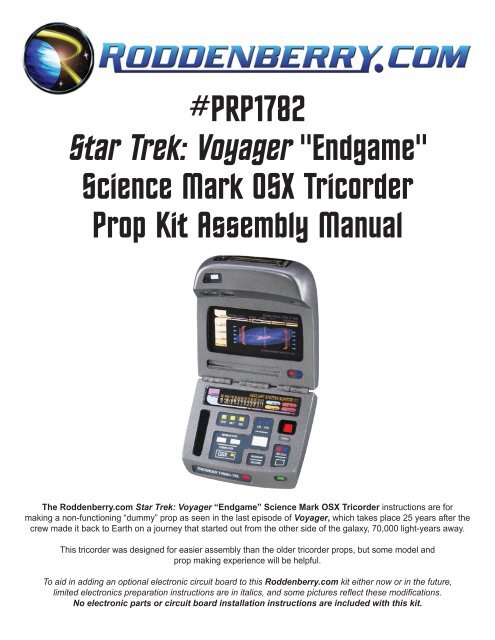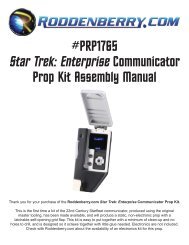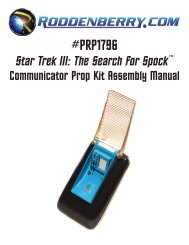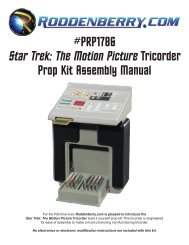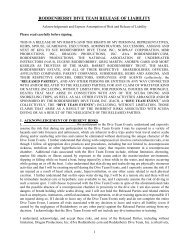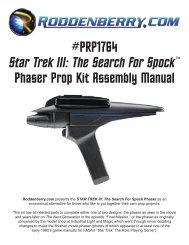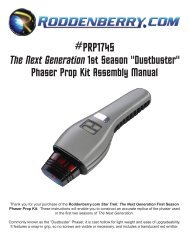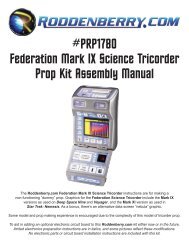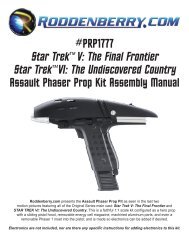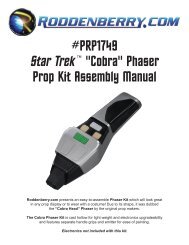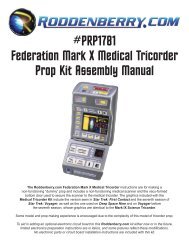Star Trek: Voyager "Endgame" - Roddenberry.com
Star Trek: Voyager "Endgame" - Roddenberry.com
Star Trek: Voyager "Endgame" - Roddenberry.com
You also want an ePaper? Increase the reach of your titles
YUMPU automatically turns print PDFs into web optimized ePapers that Google loves.
#PRP1782<br />
<strong>Star</strong> <strong>Trek</strong>: <strong>Voyager</strong> "Endgame"<br />
Science Mark OSX Tricorder<br />
Prop Kit Assembly Manual<br />
The <strong>Roddenberry</strong>.<strong>com</strong> <strong>Star</strong> <strong>Trek</strong>: <strong>Voyager</strong> “Endgame” Science Mark OSX Tricorder instructions are for<br />
making a non-functioning “dummy” prop as seen in the last episode of <strong>Voyager</strong>, which takes place 25 years after the<br />
crew made it back to Earth on a journey that started out from the other side of the galaxy, 70,000 light-years away.<br />
This tricorder was designed for easier assembly than the older tricorder props, but some model and<br />
prop making experience will be helpful.<br />
To aid in adding an optional electronic circuit board to this <strong>Roddenberry</strong>.<strong>com</strong> kit either now or in the future,<br />
limited electronics preparation instructions are in italics, and some pictures reflect these modifications.<br />
No electronic parts or circuit board installation instructions are included with this kit.
2<br />
#PRP1782 - Vo y a g e r “En d g a m e ” Sc i e n c e Ma r k OSX Tr i c or d e r Pr o p Kit As s e m b l y Ma n u a l<br />
PARTS INCLUDED:<br />
• 1 Top body (resin casting)<br />
• 1 Bottom Body (resin casting)<br />
• 1 Flap (resin casting)<br />
• 1 Bottom Door (laser-cut styrene)<br />
• 1 Flap Cover Door (laser-cut styrene)<br />
• 1 Clear Screen Window<br />
• 3 Hinges<br />
• 12 Screws for hinges<br />
• 8 @ 0-80 Screws for bottom doors<br />
• 1 Ribbed Detail Plate (will be incorporated<br />
in future castings as part of the detail)<br />
• 1 Graphics Sheet (printed vinyl sheet)<br />
• 1 Front Acrylic Rod<br />
• 1 Red Square<br />
Tools Needed:<br />
• Dremel moto tool with a 1/8” or smaller cutting bit<br />
• Drill with a 1/16” drill bit<br />
• Pliers (needlenose or other)<br />
• Screwdrivers (small jeweler’s Philips screwdriver for<br />
the 0-80 screws, and a larger one for the hinge screws)<br />
• Scissors<br />
• Hobby knife (X-acto brand or similar)<br />
• Plastic straightedge (a ruler or drafter’s triangle –<br />
see-through is helpful but not necessary)<br />
Supplies needed:<br />
• Cyanoacrylate (CA) glue, medium gap filling re<strong>com</strong>mended;<br />
and CA cure accelerator<br />
• Bondo plastic filler, and automotive spot putty<br />
• Sandpaper (220-320 grit rough sanding, 400-600 grit finish<br />
sanding)<br />
• Testors Clear Parts Cement<br />
Optional tools and materials:<br />
• Soldering iron with solder, wire (24ga. or thinner)<br />
• 1/8” drill bit, and a countersink bit<br />
• Self-healing cutting pad (available at art supply stores)<br />
• 5-minute epoxy (clear type)<br />
• Baking soda (bicarbonate of soda)<br />
Paints needed [spray paints unless noted):<br />
• Primer (sandable-type re<strong>com</strong>mended)<br />
• Medium metallic gray, such as Plastikote Medium Charcoal<br />
Gray or similar<br />
• Plastikote Black Metallic (small can)<br />
• Brush paints (Tamiya, Testors, or your choice of brand):<br />
Black (flat or semi-gloss), Gold, Copper, and Metallic Brown<br />
(Plastikote Dark Brown Metallic #1552 or #1078 (big can) or<br />
#FM8074 (small can), or a small jar of hobby paint if you<br />
can find it)
#PRP1782 - Vo y a g e r “En d g a m e ” Sc i e n c e Ma r k OSX Tr i c or d e r Pr o p Kit As s e m b l y Ma n u a l 3<br />
Step 1: Wash your resin parts with a chlorine-based cleaner such as Ajax or Comet brands and rinse with<br />
water to remove traces of mold release, which might interfere with the eventual paint finish.<br />
Step 2: Sand all mold lines/flashing and molding sprues until smooth, making sure you also lightly sand<br />
the inside edge of the display screen hole. Fill in any bubbles in the castings with CA glue or bondo. You<br />
may need to use your hobby knife to poke through any suspected voids, and pay particular attention to the<br />
pointy edge of the flap.<br />
Also sand the flashing from the two bottom doors.<br />
Step 3: Now you will glue the two body halves. Sand as much flashing as possible from the parts. You will<br />
have gaps at the back (hinge) ends of the “U” piece – remove any material that is keeping those ends from<br />
closing together, as this will also make the front curved seam more even.<br />
Hold the parts together as best you can evenly – use tape to hold them together if necessary – then glue<br />
the two ends of the “U” first.
4<br />
#PRP1782 - Vo y a g e r “En d g a m e ” Sc i e n c e Ma r k OSX Tr i c or d e r Pr o p Kit As s e m b l y Ma n u a l<br />
Step 4: Once cured, push the front corners together so they are as even with each other as possible and<br />
glue the front corners only.<br />
Step 5: After curing, you may screw the bottom door on the body and take care it goes in the right<br />
direction, as the holes are not symmetrical because of how the master sculpture was made. When the<br />
door is secure, clamp the sides closed with your hand and glue together. Also put some in the front detail<br />
side – make sure you don’t have any excess glue blobbing up in there – you can glue this seam from the<br />
inside if you like.<br />
Step 6: The screw holes in the flap door are placed where they are because of how the master flap part<br />
was originally made with an interior cavity not even on all sides, and original props were put together with<br />
the cover permanently glued on with the circuit board in place. Because of this, the cast-in screw inserts<br />
are not even and the flap door will fit best in one direction only, so all you need to do is screw the cover on<br />
for now.<br />
If you intend to make a dummy tricorder only without ever intending to install electronics, you have<br />
the alternative of simply gluing the flap cover door on, and later on you will bondo the seams and<br />
holes and sand for a smooth surface. Be sure of your decision -- if you change your mind later,<br />
you will cause considerable damage by attempting to pry a glued cover off, so using the screws is<br />
re<strong>com</strong>mended.
#PRP1782 - Vo y a g e r “En d g a m e ” Sc i e n c e Ma r k OSX Tr i c or d e r Pr o p Kit As s e m b l y Ma n u a l 5<br />
Step 7: Optional electronics preparation: You will need to glue a magnet somewhere inside the flap cavity,<br />
the actual location depends on the circuit board you have in order for it to activate a reed switch in the main<br />
body.<br />
Step 8: Optional electronics preparation: get 4 lengths of wire about 3” long for each hinge leaf – 24-gauge<br />
or smaller will work; they don’t need to be very thick. To make it easier for you in wiring your tricorder, use<br />
two different colors of wire such as red and black, and be sure you’ll remember which wire/color is positive<br />
and which one is negative/ground as you’ll be wiring your circuit board into the flap, and you’ll need to know<br />
the difference when wiring to your main circuit board/battery. Scrape clean the places on the hinges you’ll<br />
be wiring, which will be the opposite side from where the hinge axle is; you may be scraping a protective<br />
clear lacquer from the hinge surface. Solder the wires to the hinges, being sure you use the same color<br />
wire on each hinge so one hinge will have two red wires and the other will have black, or whatever colors<br />
you wish to use.
6<br />
#PRP1782 - Vo y a g e r “En d g a m e ” Sc i e n c e Ma r k OSX Tr i c or d e r Pr o p Kit As s e m b l y Ma n u a l<br />
Step 9: Carefully 1/16” drill all 12 screw holes no more than 1/2” in the flap and main body for the hinges.<br />
Step 10: For wired hinges, drill a 1/8” center hole in the two outer hinge slots of both body and flap, large<br />
enough for a wire to be put through. You may also want to countersink in slight depressions in the flap<br />
where you’ve drilled these center holes; that will make room for the wire to hinge solder joints so the hinges<br />
can sit flat in their slots.<br />
Step 11: Hinge face with all holes drilled.<br />
Step 12: Drill a 1/8” hole in the far right depression of the flap edge, and if desired, enlarge this hole into a<br />
slot with your Dremel tool. Be sure you’re angling the drill bit so it goes in the flap well.
#PRP1782 - Vo y a g e r “En d g a m e ” Sc i e n c e Ma r k OSX Tr i c or d e r Pr o p Kit As s e m b l y Ma n u a l 7<br />
Step 13: Screw the hinges to the parts. You will find that this particular tricorder was designed to make it<br />
much easier to put the hinges on straight than any of the other original tricorder props. You may use a<br />
.010 - .020 shim in between the body and the flap if you wish to keep the two parts apart, necessary to<br />
keep from damaging the paint finish of the two surfaces where they meet when the tricorder is closed.<br />
Make sure the hinges are all oriented the same way – whichever way the hinge is (the 2 side or the 3 side)<br />
to the flap should be the same on all hinges.<br />
Step 14: When the hinges are all screwed in place, the tricorder should open up flat.
8<br />
#PRP1782 - Vo y a g e r “En d g a m e ” Sc i e n c e Ma r k OSX Tr i c or d e r Pr o p Kit As s e m b l y Ma n u a l<br />
Step 15: Take the thin clear sheet and cut it with scissors so it will fill in the flat surface inside the main<br />
body; this will be the surface for putting on the main display graphic. If you cut it right, this will also cover<br />
the open slot at the hinge edge of the body. Glue in place with CA, make sure you don’t get glue on the<br />
outside surface, and be sure you glue all sides.
#PRP1782 - Vo y a g e r “En d g a m e ” Sc i e n c e Ma r k OSX Tr i c or d e r Pr o p Kit As s e m b l y Ma n u a l 9<br />
Step 16: Fill the entire body joint with bondo (with the exception of the front detail well; you shouldn’t have<br />
any gap there). In a separate operation (don’t try to do it all at once!), mask off the 3 hinges at the joints<br />
with tape and fill all the hinge wells with bondo. When cured, sand all the bondo until smooth. If, after<br />
sanding, you have spots that aren’t filled in <strong>com</strong>pletely, apply more bondo and sand until it looks good to<br />
you – you needn’t use any sandpaper finer than 320-grit at this stage.
10<br />
#PRP1782 - Vo y a g e r “En d g a m e ” Sc i e n c e Ma r k OSX Tr i c or d e r Pr o p Kit As s e m b l y Ma n u a l<br />
Painting and Graphics:<br />
Step 17: If you’re adding electronics either now or at sometime in the future, apply masking tape to the<br />
main display screen.<br />
Step 18: Now you’re ready to start the painting process. Screw both the doors in place. Hang your tricorder<br />
with a thin wire hook in such a way that you can get all of the tricorder with paint – the flap will need to be<br />
partially open so you can spray the hinge area where it will hit when fully open, then spray the first primer<br />
coat. If the hinge is loose where the flap can’t stay put when partly open, you’ll have to spray the hinged<br />
surfaces first and let dry before spraying the rest of the tricorder.
#PRP1782 - Vo y a g e r “En d g a m e ” Sc i e n c e Ma r k OSX Tr i c or d e r Pr o p Kit As s e m b l y Ma n u a l 11<br />
Step 19: When dry, check your surface for imperfections; use spot putty or bondo to fill in any bad areas,<br />
then sand and primer again until everything looks good to you.<br />
Step 20: Use Plastikote Medium Charcoal Gray #1006 for the main color.<br />
Spray your first color coat with your medium metallic gray; and when dry, wet sand with 600-grit sandpaper,<br />
then spray your final coat of paint and allow to cure at least several hours or overnight.<br />
Step 21: When your surface can survive having tape applied to it, mask the tricorder so the front detail well<br />
is exposed, then spray with Black Metallic paint.
12<br />
#PRP1782 - Vo y a g e r “En d g a m e ” Sc i e n c e Ma r k OSX Tr i c or d e r Pr o p Kit As s e m b l y Ma n u a l<br />
Step 22: Remove your masking tape. You may need to use a hobby knife on the tape edges to avoid paint<br />
on the tape lifting off paint on your prop, being careful of course not to put a knife line on your good finish!<br />
The ribbed detail plastic will be obsolete on future<br />
shipments of this tricorder as the details will be<br />
incorporated in the castings, and will be masked and<br />
spray or brush painted as part of the body detail; so<br />
until then, any reference to these separate detail parts<br />
remain in effect.<br />
Step 23: From the graphics sheet, cut out the ribbed detail cutting pattern and apply to the smooth back<br />
side of the piece of ribbed styrene plastic. Cut and/or sand this plastic to the lines and smooth the edges.<br />
Remove the cutting pattern, then spray primer and paint the ribbed side in Black Metallic and set aside.
#PRP1782 - Vo y a g e r “En d g a m e ” Sc i e n c e Ma r k OSX Tr i c or d e r Pr o p Kit As s e m b l y Ma n u a l 13<br />
Step 24: Brush paint the front details as shown. Note that the “L” looking piece is painted the same color<br />
as the tricorder. Glue the front acrylic rod in place using Testors Clear Parts Cement.<br />
The graphics go on next. Instructions for altering the<br />
graphics for a functional tricorder are not included;<br />
they go beyond the bounds of these basic assembly<br />
instructions.<br />
Step 25: Place your graphic sheet on a cutting<br />
board surface you won’t mind putting knife lines on.<br />
A self-healing cutting pad available at art supply<br />
stores is best. With a plastic straightedge (a ruler or<br />
a drafter’s triangle for example; metal rulers might<br />
damage the graphic), hold down your ruler securely<br />
and cut your graphic sheet along all edges. Use your<br />
knife or scissors to round all the corners, and apply<br />
as pictured. If you feel really adventurous, you could<br />
try cutting these graphics freehand as most of the<br />
shapes are irregular to match the holes they fit in.<br />
Test exactly where you want them first before<br />
peeling and sticking them on permanently –<br />
you may need to trim the graphics to where<br />
they’ll fit.<br />
With the main graphic, peel a little away at a time and<br />
work from one edge (the top edge may be easier to<br />
line it up with), and lay it on so you can avoid leaving<br />
bubbles inside the graphic. Once stuck down, you<br />
probably won’t be able to remove or reposition your<br />
stickers without damaging them. Apply the rest of the<br />
graphic pieces as pictured on the following page.
14<br />
#PRP1782 - Vo y a g e r “En d g a m e ” Sc i e n c e Ma r k OSX Tr i c or d e r Pr o p Kit As s e m b l y Ma n u a l<br />
Step 26: Brush paint the EMRG well detail with flat or semi-gloss black. Do not paint on the surface outside<br />
this recess well.<br />
The red EMRG square needs to be cut off to where it is about 1/8” long in length – when put in the EMRG<br />
well, it shouldn’t stick out beyond the flat surface of the flap. Cut off, sand, and/or file away the excess<br />
from the opposite end of the good flat square end – this will be very glossy and either rounded or caved<br />
in <strong>com</strong>pared to the rest of the surfaces. If you wish (especially if you’re making a non-functioning dummy<br />
tricorder), you can stick on or glue a piece of <strong>com</strong>mon aluminum foil or aluminum tape to the bottom<br />
surface of the red square; it will make it show up better in your tricorder enough to where it appears to have<br />
illumination. Glue it in place in the black EMRG well with either CA or Testors Clear Parts Cement.<br />
CA glue in place the two painted ribbed plastic details. As the patterns are asymmetrical, check the fit of<br />
both pieces before you glue them.
#PRP1782 - Vo y a g e r “En d g a m e ” Sc i e n c e Ma r k OSX Tr i c or d e r Pr o p Kit As s e m b l y Ma n u a l 15<br />
Congratulations, you have successfully assembled a<br />
<strong>Roddenberry</strong>.<strong>com</strong> “Endgame” Science Mark OSX Tricorder!<br />
IMPORTANT NOTES:<br />
The physical reproduction by any means known or yet to be invented (including molding and<br />
recasting, reverse-engineering, and stereo lithography scanning and printing) of the<br />
<strong>Roddenberry</strong>.<strong>com</strong> <strong>Star</strong> <strong>Trek</strong>: <strong>Voyager</strong> “Endgame” Science Mark OSX Tricorder #1782 or its<br />
parts and graphics; or reproducing/replicating any pre-existing products, parts, or graphics is<br />
expressly prohibited under U.S. and International copyright and product protection laws.<br />
Copyright © 2009 <strong>Roddenberry</strong> Productions.<br />
<strong>Star</strong> <strong>Trek</strong> and related marks and logos are Trademarks of CBS Studios Inc. All rights reserved.


